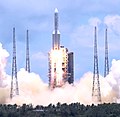This article needs additional citations for verification .(July 2022) |
 | |||||||||||||||||||||||||
 | |||||||||||||||||||||||||
| Location | Wenchang, Hainan, China | ||||||||||||||||||||||||
|---|---|---|---|---|---|---|---|---|---|---|---|---|---|---|---|---|---|---|---|---|---|---|---|---|---|
| Coordinates | 19°36′52.17″N110°57′4.08″E / 19.6144917°N 110.9511333°E | ||||||||||||||||||||||||
| Operator | CASC | ||||||||||||||||||||||||
| Total launches | 39 | ||||||||||||||||||||||||
| Launch pad(s) | Two | ||||||||||||||||||||||||
| |||||||||||||||||||||||||
| Wenchang Space Launch Site | |||||||
|---|---|---|---|---|---|---|---|
| Simplified Chinese | 文昌航天发射场 | ||||||
| Traditional Chinese | 文昌航天發射場 | ||||||
| |||||||
The Wenchang Space Launch Site (Chinese:文昌航天发射场 [1] [2] ) is a rocket launch site located in Wenchang on the island of Hainan, in China.
Contents
- Reasons for selection
- Location
- Economic potential
- Planning and construction
- Launch pads
- Launch statistics
- Rocket configurations
- Launch history
- Previous launches
- Next launches
- See also
- References
- External links
Formally a suborbital test center, it currently serves as China's southernmost spaceport. The site was selected for its low latitude, 19° north of the equator, allowing for larger payloads to be launched. It is capable of launching the Long March 5, the heaviest Chinese rocket. [3] Unlike launch facilities on the mainland, Wenchang uses its seaport for deliveries.
The construction of the site was complete by October 2014. [4] The first launch took place on 25 June 2016. [5] Due to construction delays, the initial launch of the CZ-5 booster from Wenchang, originally expected to start in 2014 [6] was postponed and took place on 3 November 2016. [7] The CZ-5B (maximum payload to LEO) variant was expected to be completed circa 2018 [8] but the maiden flight took place on 5 May 2020. A CZ-5 carrier rocket was already shipped from North China's Tianjin port on 20 September 2015 for rehearsal drills of a scheduled Chang'e-5 lunar mission, which was planned for around 2019 [9] and was successfully launched on 23 November 2020.








